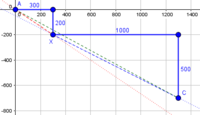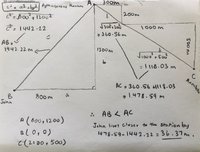You are using an out of date browser. It may not display this or other websites correctly.
You should upgrade or use an alternative browser.
You should upgrade or use an alternative browser.
Shortest distance
- Thread starter Learnerzz
- Start date
D
Deleted member 4993
Guest
Please show us what you have tried and exactly where you are stuck.Grade 9 maths- thanks for your help! Question is in the picture attached.
Please follow the rules of posting in this forum, as enunciated at:
https://www.freemathhelp.com/forum/threads/read-before-posting.109846/#post-486520
Please share your work/thoughts about this assignment.

Steven G
Elite Member
- Joined
- Dec 30, 2014
- Messages
- 14,382
You thanked us for our help. Can we please explain what type of help you were.are looking for? I'm just curious.Grade 9 maths- thanks for your help! Question is in the picture attached.
I changed the 800 km to 800 m because I believe it's a mistake. I tried drawing the diagram and used Pythagorus to find the unknown sides. I'm not sure if I'm right...but I made more progress.First try to make a draw using a rectangular system of coordinates (x,y). From there I think you can figure out the right answer.
Attachments
Dr.Peterson
Elite Member
- Joined
- Nov 12, 2017
- Messages
- 16,074
You're doing some of the right things, but I think you put the 300 m distance with the wrong person. More importantly, for AC, you can't add two distances that are not in the same direction. Rather, turn each person's trip into a single equivalent right triangle; or else use coordinates, which amounts to the same thing. You need to find a single hypotenuse.
Thank you for that! I don't see why for AC the two distances are not in the same direction. Also, could you explain how I can find a single hypotenuse?You're doing some of the right things, but I think you put the 300 m distance with the wrong person. More importantly, for AC, you can't add two distances that are not in the same direction. Rather, turn each person's trip into a single equivalent right triangle; or else use coordinates, which amounts to the same thing. You need to find a single hypotenuse.
Dr.Peterson
Elite Member
- Joined
- Nov 12, 2017
- Messages
- 16,074
I suggested using coordinates. Here is a "map" of the route you drew (which is wrong in several ways):Thank you for that! I don't see why for AC the two distances are not in the same direction. Also, could you explain how I can find a single hypotenuse?

Do you see that the red and blue dotted lines are not in the same direction? You could determine that by finding their slopes. Therefore, the green line is not the sum of the red and blue lines.
Now just correct your paths, and find coordinates of each point. Then you can use the distance formula to find the real distances AB and AC.
HallsofIvy
Elite Member
- Joined
- Jan 27, 2012
- Messages
- 7,763
Setting up a coordinate system as suggested, take John's house to be (0, 0), the x-axis east-west, the y-axis north-south.
John first walked 800 m east (your problem says 800 km but that has to be wrong! All the other distances are in m and it would take days to walk 800 km!). So John goes to (800, 0). Then he walks 1.2 km= 1200 m north, to (800, 1200). Then he walks 300 m east to (1600, 1200). What is the straight line distance between (0, 0) and (1600, 1200)?
John first walked 800 m east (your problem says 800 km but that has to be wrong! All the other distances are in m and it would take days to walk 800 km!). So John goes to (800, 0). Then he walks 1.2 km= 1200 m north, to (800, 1200). Then he walks 300 m east to (1600, 1200). What is the straight line distance between (0, 0) and (1600, 1200)?


